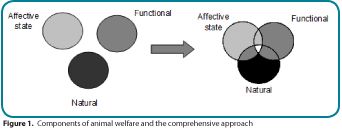Science of Ethology, Volume 1, Issue 1
Concern for animal welfare is evident at all levels of swine production, from producers and industry to society and consumers, and takes different forms at each level. For the individual producer, it involves daily decisions on the basic care of animals- from feeding and general management, to the quality of health checks and maintaining vaccination protocols. Within the pork industry, concern for animal welfare takes the form of codes of practice and quality assurance programs designed to define acceptable industry standards for the care and management of animals. From a societal perspective, concern for animal welfare is shown in laws governing major issues such as humane slaughter and housing practices, as well as in the purchasing choices of individual consumers.
Few consumers know, or are able to select, the farm from which they obtain their food. Their satisfaction with their food relies on their confidence in the industry which produces it. As such, the importance of animal welfare has increased, and with it the need for producers and the livestock industry to demonstrate good care. The field of animal welfare science arose along-side these changes as a tool to help address questions related to management practices that affect the physical and psychological well-being of animals. This article describes general perspectives in animal welfare science, it explores the measures used in welfare science, and how these measures are used to evaluate management practices.
As David Fraser of the University of British Columbia describes in his recent book, Understanding Animal Welfare (2008), animal welfare is generally viewed from three philosophical perspectives, with each perspective emphasizing different components of welfare.
One approach to animal welfare examines how well animals function in their environment. The ‘functional approach’ assumes that if animals are healthy and productive their welfare must also be good, and uses measures related to growth, reproduction, and health (or absence of poor health) to demonstrate good welfare. Physiological measures indicative of stress are also used to demonstrate how well animals are functioning in their production system.
The functional approach can be applied to plants just as well as it can to animals, yet we are more concerned about the welfare of animals than that of plants. The reason for this is that animals are sentient, that is, they have feelings. We recognize that animals can feel pain, experience fear, and have a sense of comfort and discomfort. A second component of animal welfare relates to these ‘affective states’, or how animals feel. This approach emphasizes the importance of emotional states and the feelings of animals, using measures such as pain, fear and discomfort (or alternatively, positive emotions) as indicators of well-being.
The third component of animal welfare is known as the ‘natural approach’. Through thousands of years living in the wild, our animals have relied on their natural responses to cope with environmental challenges. When they encounter similar challenges in our production systems, they will attempt to use these same natural responses to attempt to cope. Among other things, our animals will use exploratory behaviour to become familiar with their environment, to adapt their social behaviour to alleviate competition, and use thermoregulatory behaviour to avoid cold or extreme heat. If the animal is unable to express these behaviours, it will become frustrated and stressed. It may be able to express the behaviours, but be ineffective in coping because a critical part of the environment is missing, for example, a wallow (cooling device) in hot conditions. In some cases, the behaviour may be harmful, such as when attempts to root for food result in injury. The natural approach considers how well the system accommodates the responses of the animal. Its motto can be expressed as ‘fit the farm to the animal, not the animal to the farm’. Freedom of movement is a critical component of the natural approach to animal welfare.
While these three approaches- ‘functional’, ‘affective states’ and ‘natural’- can be used separately, when used alone they run the risk of jeopardizing other components of animal welfare. Rather than placing our emphasis on any one component of animal welfare, we should look for systems that overlap (see Figure 1), and meet a comprehensive definition: a system in which an animal functions well, in which positive feelings outweigh negative, and in which it can express its natural behaviour in an effective manner.
This comprehensive definition of animal welfare meets the approval of most members of society. It is also evident in the Five Freedoms(Table 1), which are accepted guidelines for animal well-being used by many animal production organizations. In the current revision process for Canadian Codes of Practice, for pigs and other species, the mandate includes this comprehensive approach. The challenge to modern producers will be to achieve these goals in a production system that is also efficient and profitable. From a research perspective, the challenge to scientists at the Prairie Swine Centre is to identify management practices that can optimize animal welfare while at the same time maintaining or improving productivity, efficiency and profitability. This is the first in a series of articles using animal welfare science to address production issues in modern pork production.
References
Fraser, D. 2008, Understanding Animal Welfare: the science in its cultural context. Wiley-Blackwell, Hoboken, NJ. Farm Animal Welfare Council, 1979. See http://www.fawc.org.uk/freedoms.htm a ‘drop-off’ in the middle of the day. Comparing these results with other studies suggests that the younger pigs were limited in the number of feeder spaces, and had to shift eating from the normal peak periods to the less intensive mid-day period.











